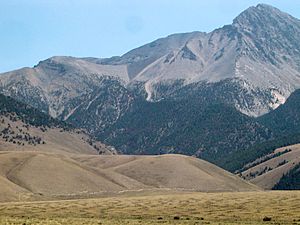Scarp (landform) facts for kids

A scarp is a steep slope or a cliff. Imagine a giant step in the land! The word "scarp" comes from the Italian word scarpa, which means 'shoe'. The actual surface of this steep slope is called a scarp face.
Sometimes, a scarp is formed when the Earth's crust moves along a fault. This kind of steep cliff is called a fault scarp. It happens when one side of the fault moves up, making a higher area next to a lower one.
An escarpment is a long, steep slope or cliff. It forms because of faulting and the wearing away of rock (called erosion). An escarpment usually separates two flatter areas that are at different heights. A special type of escarpment is a cuesta. This is a ridge that is steep on one side (the escarpment) and gently sloped on the other side.
How Scarps Are Formed
Scarps are usually created in two main ways:
- Erosion of Rocks: This happens when different types of sedimentary rocks wear away at different speeds. Harder rocks resist erosion more, while softer rocks wear away faster, leaving a steep edge.
- Earth's Crust Movement: Sometimes, the Earth's crust moves vertically along a geologic fault. When one side of the fault moves up, it lifts the ground, creating a steep drop-off known as a fault scarp. This makes a high area right next to a lower area.
Most often, an escarpment shows where one set of sedimentary rocks changes into another set that is different in age and type.
Scarps can also be found along coastlines. Here, the sea's waves can erode the base of a high plateau, creating a sudden, steep change in height between the coastal lowlands and the higher land.



